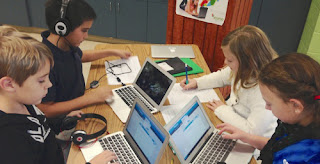What Can Teachers and Students Teach Us About Project Based Learning?
Although Project Based Learning is not an entirely new practice, its way into many classrooms is still "an uphill climb," as said in "The Power of Project Based Learning." However, those experienced in Project Based Learning can point out the numerous ways it can beneficial to all in the classroom.
1. It captures students' attention.
Instead of instructing students to complete an assignment, teachers can find ways to motivate the students to become interested in the subject first. "Seven Essentials for Project-Based Learning" suggests that teachers use an entry event to introduce projects. Entry events could be a field trip, guest speaker visiting the class, or simply a thought-provoking video. Students are more likely to engage in the project if they feel a connection or an obligation to the project.
After the entry event, the class can discuss the driving question. Driving questions must be thought-provoking and pose an issue students must work to resolve or discover an answer to. Tony Vincent explains in the video "Project Based Learning for Teachers": "The question is deep and requires students to complete an end product to share their learning with others." As mentioned in "Seven Essentials for Project-Based Learning," driving questions enable students to realize why they are doing the project.
2. It gives students a choice.
Dr. Strange has said in class before that students will be more invested in the project if they have the power to make their own choices within the project. "Seven Essentials for Project-Based Learning" makes the same claim. Teachers can make limited guidelines, but must structure the projects to foster this student decision-making. Vincent claims that students need to "take charge" of their own learning, and teachers must allow them to do this appropriately.
3. Technology prepares students for careers of the future.
Project Based Learning can include the use of technology for an enhanced learning experience. Since technology is now a prevalent part of everyday life, teachers must use technology in effective ways. Since technology evolves and grows everyday, teachers prepare students for this future. Vincent and "Ten Sites Supporting Digital Classroom Collaboration in Project Based Learning" list many online resources that can be used in project-based learning. Both mention Linoit, an online display board that can be viewed by the entire class or an entire group.
4. It allows students to work productively with their peers.
There are few (if any) career paths that require no interaction with peers and others, so collaboration between students is also preparing them for the future. Vincent says this collaboration fosters early communication skills as well as critical thinking skills. Students are also able to evaluate their peers' work and give feedback, as mentioned in "Seven Essentials for Project-Based Learning." In Project Based Learning, students work together as a team to achieve success.
5. The students' work has a purpose.
Project Based Learning relates learning to real world situations. In the video "PBL: What motivates students today" many students say their dreams and ambitions motivate them to do their best in school. Teachers must be show why their students' work is important, and they also be able to relate it to real-life situations. Terry Smith, a fourth grader teacher at an inner city school, says in "The Power of Project Based Learning" that his students are excited to make connections with students and schools in other countries in their projects. When a student's work has an audience, the student is more likely to give more effort to his/her schoolwork.
Project Based Learning enables students to really learn, not just learn and then forget. As Gary Stager says in "The Power of Project Based Learning," “Projects are the learning that students remember long after the bell rings.”

Great job!
ReplyDelete